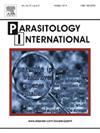Molecular phylogeny by Bayesian analysis and description of a new species of Henneguya, a parasitic cnidarian from Astyanax bimaculatus (Linnaeus, 1758) (Characiformes: Acestrorhamphidae) in Caatinga: A biome with neglected biodiversity data
IF 1.9
4区 医学
Q3 PARASITOLOGY
引用次数: 0
Abstract
Myxozoans are cnidarian parasites with a worldwide distribution and represent some of the most spectacular examples of parasite radiation. Based on an integrative taxonomic approach that includes spore morphology and molecular data, as well as other phenotypic characters such as host specificity, a new myxozoan, Henneguya caraubensis n. sp., is described from the gills of Astyanax bimaculatus (Linnaeus, 1758). Plasmodia were located within the gill lamellar epithelium, without connective tissue surrounding them. Mature myxospores were ellipsoidal in the frontal view, measuring 27.2 ± 2.6 μm in total length, 10.3 ± 0.7 μm in body length of spore, and 3.9 ± 0.2 μm in width. Two polar capsules elongated pyriform in shape, equal in size, measuring 3.4 ± 0.3 μm in length and 1.2 ± 0.1 μm in width. Polar tubules had 5 to 6 coils. Histopathological analysis showed large intralamellar polysporic plasmodia associated with displacement, deformation, and fusion of the nearest gill lamellae and with the adjacent lamellae being pushed laterally. Bayesian inference SSU rDNA-based phylogenetic analyses showed a strong tendency of Henneguya/Myxobolus species to form clusters mainly based on the order and/or family of the host, despite having different geographic origins. Phylogenetically, the novel species grouped within a clade containing Henneguya/Myxobolus spp. and appears in a well-supported subclade of Henneguya species parasites of Astyanax fishes. Our study reinforces highly endemic diversity still hidden that inhabits the Caatinga biome and points out the need to improve the strategies of protection and conservation of this threatened ecoregion with neglected biodiversity data.

基于贝叶斯的分子系统发育分析及Caatinga (Linnaeus, 1758)寄生性刺胞动物Henneguya新种的描述(特征:刺胞动物科):一个生物多样性数据被忽视的生物群系
黏液动物是一种分布在世界各地的刺胞寄生虫,是寄生虫辐射的一些最引人注目的例子。基于包括孢子形态和分子数据以及宿主特异性等其他表型特征在内的综合分类方法,从Astyanax bimaculatus (Linnaeus, 1758)的鳃中描述了一种新的黏液动物,Henneguya caraubensis n. sp.。疟原虫位于鳃板层上皮内,周围无结缔组织。成熟黏液孢子正面呈椭圆形,全长27.2±2.6 μm,孢子体长10.3±0.7 μm,孢子宽3.9±0.2 μm。两个极性胶囊呈梨形拉长,大小相等,长3.4±0.3 μm,宽1.2±0.1 μm。极管有5到6个线圈。组织病理学分析显示,大的层内多孢子疟原虫与最近的鳃片移位、变形和融合有关,并与相邻的鳃片被推向外侧。基于贝叶斯推理SSU rdna的系统发育分析显示,尽管不同的地理起源,但Henneguya/Myxobolus物种主要根据宿主的目和/或科形成集群。在系统发育上,该新种被归为包含Henneguya/Myxobolus sp .的分支,并出现在Astyanax鱼类寄生虫Henneguya种的一个支持良好的亚分支中。我们的研究强调了Caatinga生物群系中仍然隐藏的高度地方性多样性,并指出需要改进对这一被忽视的生物多样性数据的保护和保护策略。
本文章由计算机程序翻译,如有差异,请以英文原文为准。
求助全文
约1分钟内获得全文
求助全文
来源期刊

Parasitology International
医学-寄生虫学
CiteScore
4.00
自引率
10.50%
发文量
140
审稿时长
61 days
期刊介绍:
Parasitology International provides a medium for rapid, carefully reviewed publications in the field of human and animal parasitology. Original papers, rapid communications, and original case reports from all geographical areas and covering all parasitological disciplines, including structure, immunology, cell biology, biochemistry, molecular biology, and systematics, may be submitted. Reviews on recent developments are invited regularly, but suggestions in this respect are welcome. Letters to the Editor commenting on any aspect of the Journal are also welcome.
 求助内容:
求助内容: 应助结果提醒方式:
应助结果提醒方式:


